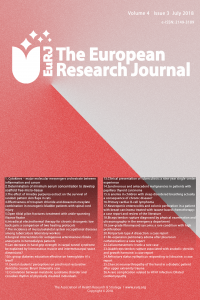Abstract
References
- [1] Dias OM, Teixeira LR, Vargas FS. Reexpansion pulmonary edema after therapeutic thoracentesis. Clinics 2010;65:1387-9.
- [2] Kim JJ, Kim YH, Choi SY, Jeong SC, Moon SW. Contralateral reexpansion pulmonary edema with ipsilateral collapsed lung after pleural effusion drainage: a case report. J Cardiothorac Surg 2015;10:68.
- [3] Verhagen M, van Buijtenen JM, Geeraedts LMG. Reexpansion pulmonary edema after chest drainage for pneumothorax: A case report and literature overview. Respir Med Case Rep 2015;14:10-12.
- [4] Kasmani R, Irani F, Okoli K, Mahajan V. Re-expansion pulmonary edema following thoracentesis. CMAJ 2010;182:2000-2.
- [5] de Wolf SP, Deunk J, Cornet AD, Elbers PW. Case Report: Bilateral reexpansion pulmonary edema following treatment of a unilateral hemothorax. Research 2014:3:318.
- [6] Corcoran JP, Psallidas I, Wrightson JM, Hallifax RJ, Rahman NM. Pleural procedural complications: prevention and management. J Thorac Dis 2015;7:1058-67.
- [7] Özsin KK, Toktaş F, Sanrı US, Kahraman N, Yavuz Ş. Re-expansion pulmonary edema caused by pleural effusion drainage in late period after coronary artery bypass surgery: case report. Turkiye Klinikleri Arch Lung 2017;18:25-8.
Abstract
Re-expansion pulmonary edema (RPE) is a rare but
potentially hazardous complication following evacuation of the pleural region.
Symptomatic RPE occurs in less than 1% of patients after pleural drainage.
Early diagnosis and treatment determines the progression of the disease and it
is life-saving. The present case describes a 68-year-old man who developed RPE
with the ipsilateral collapsed lung 6 hours after pleural drainage of a
non-malignant effusion. He was intubated and 6 hours after aggressive treatment
with mechanical ventilation support oxygenation was improved and the patient's
blood gas analysis recovered. Over the course of his 12-day hospitalization, he
was extubated and oxygen support was slowly weaned down. Mortality rate of RPE
in severe cases is approximately
20%, therefore preventive interventions gain importance. In spite of the rare
incidence of RPE, being aware of this potential condition can allow for early
and proper management.
References
- [1] Dias OM, Teixeira LR, Vargas FS. Reexpansion pulmonary edema after therapeutic thoracentesis. Clinics 2010;65:1387-9.
- [2] Kim JJ, Kim YH, Choi SY, Jeong SC, Moon SW. Contralateral reexpansion pulmonary edema with ipsilateral collapsed lung after pleural effusion drainage: a case report. J Cardiothorac Surg 2015;10:68.
- [3] Verhagen M, van Buijtenen JM, Geeraedts LMG. Reexpansion pulmonary edema after chest drainage for pneumothorax: A case report and literature overview. Respir Med Case Rep 2015;14:10-12.
- [4] Kasmani R, Irani F, Okoli K, Mahajan V. Re-expansion pulmonary edema following thoracentesis. CMAJ 2010;182:2000-2.
- [5] de Wolf SP, Deunk J, Cornet AD, Elbers PW. Case Report: Bilateral reexpansion pulmonary edema following treatment of a unilateral hemothorax. Research 2014:3:318.
- [6] Corcoran JP, Psallidas I, Wrightson JM, Hallifax RJ, Rahman NM. Pleural procedural complications: prevention and management. J Thorac Dis 2015;7:1058-67.
- [7] Özsin KK, Toktaş F, Sanrı US, Kahraman N, Yavuz Ş. Re-expansion pulmonary edema caused by pleural effusion drainage in late period after coronary artery bypass surgery: case report. Turkiye Klinikleri Arch Lung 2017;18:25-8.
Details
| Primary Language | English |
|---|---|
| Subjects | Health Care Administration |
| Journal Section | Case Reports |
| Authors | |
| Publication Date | July 4, 2018 |
| Submission Date | January 1, 2018 |
| Acceptance Date | February 2, 2018 |
| Published in Issue | Year 2018 Volume: 4 Issue: 3 |



